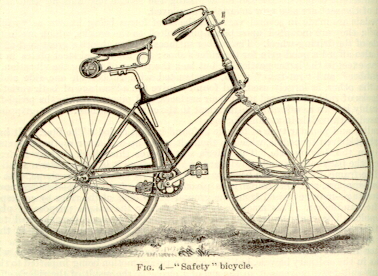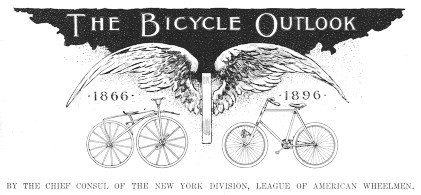Lallement's Bicycle
Today, we look for the inventor of the bicycle. The University of Houston's College of Engineering presents this series about the machines that make our civilization run, and the people whose ingenuity created them.
I'm so tired of priority disputes. Ideas rise out of communities of creative people. Priority is usually meaningless. Take the bicycle: the first bicycle had two wheels with a saddle to support the weight of a person walking. When a German invented it in 1817, it was an immediate hit. So English and French inventors tried to claim it for their countries.
By 1867 the Michaux family in Paris was selling a bike with a brilliantly simple innovation. It had a crank pedal on the front wheel -- like the tricycle you rode when you were three.
With that, bicycles became machines that could really speed personal movement. Chains and sprockets weren't perfected for another 20 years. But already, by the late 1860s, the bicycle had emerged as a practical new medium of personal transport.
Now the plot thickens: histories credit a French blacksmith, Pierre Michaux, with putting pedals on bikes. My 1970 Britannica also mentions a disgruntled mechanic, Pierre Lallement, who (it says) left Michaux in 1866. He went to America, where he got a patent for the pedal bike. The Britannica does everything but come out and say he stole the idea.
David Herlihy recently sent me a packet about the Lallement Memorial Committee in Boston, where Lallement died in 1891. His group has named a bicycle path after him, and it's working on a memorial. Herlihy doesn't claim to resolve old priority disputes. Rather, he seeks to give a very creative contributor his due.
Lallement began thinking about bicycles in 1862, when he was only 19. That year he worked for a company making wheelchairs and baby carriages. An old ship manifest shows he came to America in 1865, not 1866. And here he did get the first pedal-bike patent.
The French eventually claimed the Michaux company had produced 400 pedal bikes in 1865 -- that Michaux got the idea back in 1861, from a crank-driven grinding wheel. But records show no evidence of bike production until 1867 -- two years after Lallement left.
The old 1911 Britannica was probably closer to the truth. It hinted that Lallement and a younger Michaux, Ernest, collaborated. Herlihy digs into French records and finds two brothers -- both engineering students -- named Olivier. The Oliviers seem to have engaged the elder Michaux to run a bicycle factory for them. The Oliviers probably worked with their young contemporary, Lallement, before he came here -- and before they teamed up with Michaux.
So it's an old story. The closer we look, the more people take part in invention. The French-American dispute over credit only bends the truth and pulls us all down. Meanwhile, Boston celebrates this creative young immigrant. For, however the pedal bike came into being, Pierre Lallement was certainly part of it. And he, at the very least, was first to show America what biking could be.
I'm John Lienhard, at the University of Houston, where we're interested in the way inventive minds work.
(Theme music)
Pratt, C.E., Pierre Lallement and his Bicycle (David Herlihy, ed.), 1992. Brochure produced by the Lallement Memorial Committee. The text was first issued by Pratt in 1883.
I am grateful to David Herlihy for his counsel.

Safety Bicycle
From Appleton's Cyclopaedia of Applied Mechanics, 1892

The transition to the new safety bicycle is dramatically illustrated in
this article heading from the September, 1896, Century Magazine.